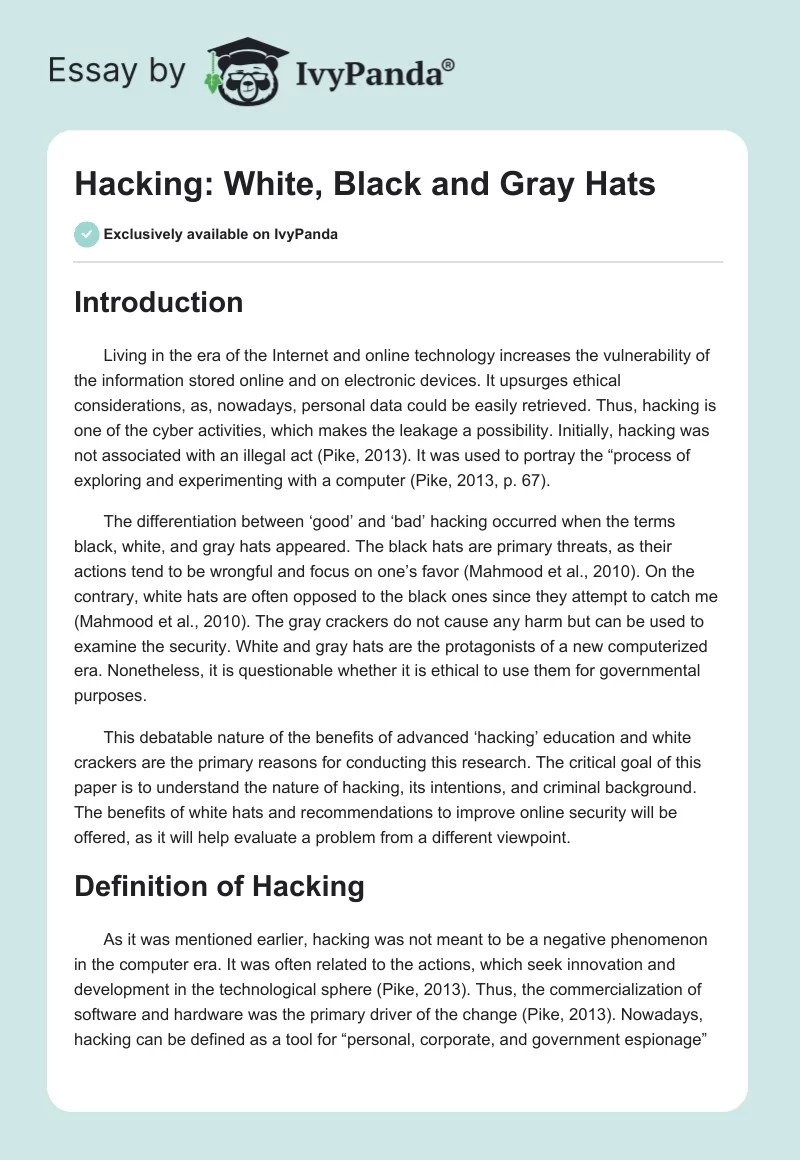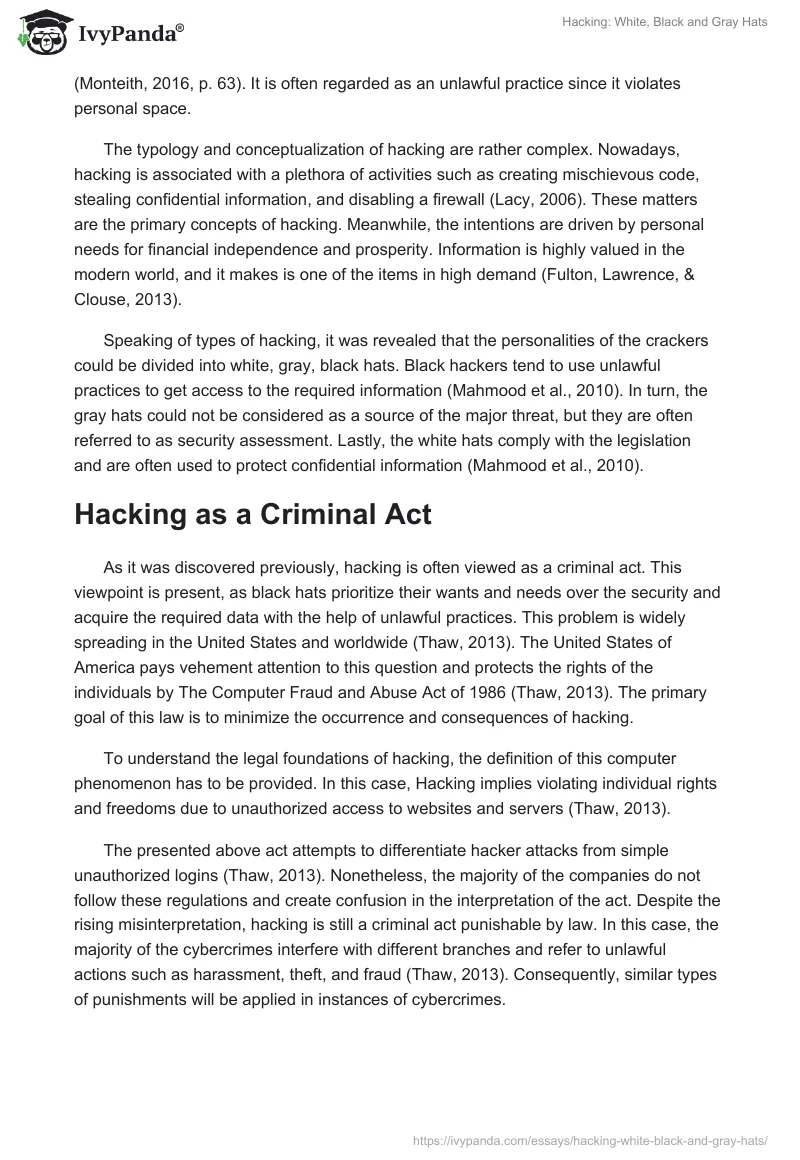Introduction
Living in the era of the Internet and online technology increases the vulnerability of the information stored online and on electronic devices. It upsurges ethical considerations, as, nowadays, personal data could be easily retrieved. Thus, hacking is one of the cyber activities, which makes the leakage a possibility. Initially, hacking was not associated with an illegal act (Pike, 2013). It was used to portray the “process of exploring and experimenting with a computer (Pike, 2013, p. 67).
The differentiation between ‘good’ and ‘bad’ hacking occurred when the terms black, white, and gray hats appeared. The black hats are primary threats, as their actions tend to be wrongful and focus on one’s favor (Mahmood et al., 2010). On the contrary, white hats are often opposed to the black ones since they attempt to catch me (Mahmood et al., 2010). The gray crackers do not cause any harm but can be used to examine the security. White and gray hats are the protagonists of a new computerized era. Nonetheless, it is questionable whether it is ethical to use them for governmental purposes.
This debatable nature of the benefits of advanced ‘hacking’ education and white crackers are the primary reasons for conducting this research. The critical goal of this paper is to understand the nature of hacking, its intentions, and criminal background. The benefits of white hats and recommendations to improve online security will be offered, as it will help evaluate a problem from a different viewpoint.
Definition of Hacking
As it was mentioned earlier, hacking was not meant to be a negative phenomenon in the computer era. It was often related to the actions, which seek innovation and development in the technological sphere (Pike, 2013). Thus, the commercialization of software and hardware was the primary driver of the change (Pike, 2013). Nowadays, hacking can be defined as a tool for “personal, corporate, and government espionage” (Monteith, 2016, p. 63). It is often regarded as an unlawful practice since it violates personal space.
The typology and conceptualization of hacking are rather complex. Nowadays, hacking is associated with a plethora of activities such as creating mischievous code, stealing confidential information, and disabling a firewall (Lacy, 2006). These matters are the primary concepts of hacking. Meanwhile, the intentions are driven by personal needs for financial independence and prosperity. Information is highly valued in the modern world, and it makes is one of the items in high demand (Fulton, Lawrence, & Clouse, 2013).
Speaking of types of hacking, it was revealed that the personalities of the crackers could be divided into white, gray, black hats. Black hackers tend to use unlawful practices to get access to the required information (Mahmood et al., 2010). In turn, the gray hats could not be considered as a source of the major threat, but they are often referred to as security assessment. Lastly, the white hats comply with the legislation and are often used to protect confidential information (Mahmood et al., 2010).
Hacking as a Criminal Act
As it was discovered previously, hacking is often viewed as a criminal act. This viewpoint is present, as black hats prioritize their wants and needs over the security and acquire the required data with the help of unlawful practices. This problem is widely spreading in the United States and worldwide (Thaw, 2013). The United States of America pays vehement attention to this question and protects the rights of the individuals by The Computer Fraud and Abuse Act of 1986 (Thaw, 2013). The primary goal of this law is to minimize the occurrence and consequences of hacking.
To understand the legal foundations of hacking, the definition of this computer phenomenon has to be provided. In this case, Hacking implies violating individual rights and freedoms due to unauthorized access to websites and servers (Thaw, 2013).
The presented above act attempts to differentiate hacker attacks from simple unauthorized logins (Thaw, 2013). Nonetheless, the majority of the companies do not follow these regulations and create confusion in the interpretation of the act. Despite the rising misinterpretation, hacking is still a criminal act punishable by law. In this case, the majority of the cybercrimes interfere with different branches and refer to unlawful actions such as harassment, theft, and fraud (Thaw, 2013). Consequently, similar types of punishments will be applied in instances of cybercrimes.
Controversies and Benefits of White Hats
It remains apparent that not all types of hackers are dangerous to modern society. For instance, white hats are often viewed as a “new breed” (Lacy, 2006, p. 2). The companies often hire or train this professional to prevent hacking attacks and minimize the leakage of information. There are several reasons for the rising popularity of this trend among the well-known companies. One of them is the improved security levels, as addressing services of white hats is more effective than using the firewall (Fulton et al., 2013). Another advantage of this type of hackers is the fact that it is a suitable approach to study the behavior of black hats and stop their actions (Fulton et al., 2013). Thus, white hats can be regarded as a new security mechanism, which is effective and cost-efficient.
However, one has to consider risks of white hats, as the availability of the specialized education portrays that any individual can become a qualified hacker within weeks (Lacy, 2006). This matter increases threats to online security since these competencies can be used in illegal practices. It could be said that the aspects mentioned above underline ethical controversies in using and educating white hats in governmental and organizational purposes.
Recommendations to Improve Security
Nonetheless, there are several approaches to improve online security at international, national, and individual levels. One of them is conducting the research on black hat activity, as it can help prevent future attacks (Mahmood et al., 2010). In this case, the governmental website could be used as sources of information. However, security professionals can also apply ‘honeypots’. This approach implies developing a trap for hackers by creating a perception that the falsely valuable information is treasured (Mahmood et al., 2010).
An alternative solution is the development of online security skills and competences. Following this strategy will help minimize the risks of black hacking. The recent research underlines that the profession of white hacker will rise in demand in the recent future (Fulton et al., 2013). For instance, international corporations are under aggressive attacks of crackers on a weekly basis (Fulton et al., 2013).
Companies such as Apple and LinkedIn require professionals, who will help them protect their information from leakage to the competitors (Fulton et al., 2013). In this case, particular attention has to be paid to the development of the competencies such as cryptography, computer forensics, security engineering, and ethics (Fulton et al., 2013). Prioritizing these skills will help educate qualified professionals and improve the level of Internet security.
Lastly, personal safety plays a pivotal role in the protection of individual data. Due to the popularity of the technological devices among the individuals of all generations, the vulnerability of children for black hat attacks cannot be underestimated (Monteith, 2016). In this case, learning the basic principles of Internet security will help not become victims of cyber-attacks. For instance, one should set difficult passwords and modify them regularly (Monteith, 2016). Following simple rules like this one will help optimize the work of the security system and minimize the possibility of information leakage.
Conclusion
In the end, hacking is often viewed as a criminal activity. These assumptions are rational since, nowadays, hacking means to ‘steal’ the privately stored data in personal interests. Moreover, it is regarded as a criminal act since it has a tendency to violate individual rights and freedoms. These aspects depict the fact that hacking causes a threat to online security at national and international levels.
Nonetheless, the constant development of technology evoked the development of new professions. Living in the era of virtual reality changes a perception towards white hacking and makes it one of the tools to prevent the leakage of confidential information. Today, many companies with a well-established brand name educate white hat professionals to reveal additional information about the actions of black hats and ensure high levels of security in the organization. However, despite the positive intentions of the profession, the ethical nature of white hacking is questionable, as the behavior of educated individuals cannot be predicted.
References
Fulton, E., Lawrence, C., & Clouse, S. (2013). What hats chasing white hats: Careers in IT and the skills required to get there. Journal of Information Systems Education, 24(1), 75-80.
Lacy, S. (2006). What I learnt at hacker camp. Web.
Mahmood, M., Siponen, M., Straub, D., Rao, R., & Raghu, T. (2010). Moving toward black hat research in information systems security: An editorial introduction to the special issue. MIS Quarterly, 34(3), 431-433.
Monteith, B. (2016). Hacking for good and bad, and how to protect yourself against hacks! Knowledge Quest, 44(4), 60-64.
Pike, R. (2013). The “ethics” of teaching ethical hacking. Journal of International Technology and Information Management, 22(4), 67-75.
Thaw, D. (2013). Criminalizing hacking, not dating: Reconstructing CFAA intent requirement. The Journal of Criminal Law and Criminology, 103(3), 907-948.


